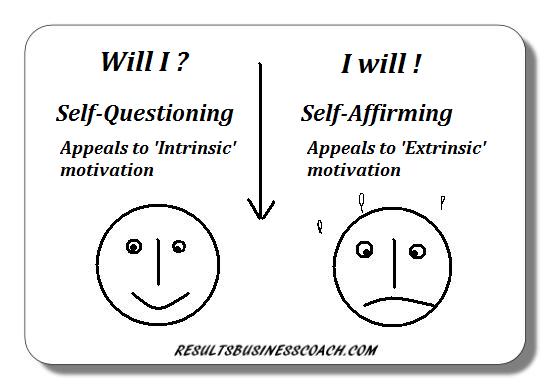Whether we are aware of it or not, we are always talking to ourselves. This ‘self-talk’ has been heavily discussed in personal development circles. We are all encouraged do positive affirmations’ (like “I can do” X …).
Here is an interesting twist…
Ibrahim Senay and Dolores Albarracin, at the University of Illinois conducted an interesting experiment.
53 undergraduates were split into two groups. The first group was asked to think about “whether they want” to work on anagrams and the second group was asked to think about “working on” anagrams. That is the first group was subjected to “Will I” condition and the second group to “I will” condition.
Logic would suggest the second group (“I Will) should solve more anagrams than the first. Simply because the “I will” commits them to the task. But surprisingly the first group (“Will I”) solved 25% more anagrams.
This experiment was repeated with a slight variation and the results were the same. I.e. the self-questioning group (“Will I”) performed much better than the self-affirming (“I Will”) group.
Why?
It is suggested that with self-questioning (“Will I”) we trigger conditions for ‘intrinsic motivation'(Intrinsic Motivation is based on taking pleasure in an activity rather working towards an external reward as opposed to Extrinsic motivation, which refers to the performance of an activity in order to attain an outcome, which then contradicts intrinsic motivation)
Can we fix it?
 Daniel Pink, author of “Drive”, sites Bob the builder as an example of this. In an article in the telegraph he says the following about Bob. “Instead of puffing up himself and his team, he first wonders whether they can actually achieve their goal. In asking his signature question – Can we fix it? – he introduces some doubt.”
Daniel Pink, author of “Drive”, sites Bob the builder as an example of this. In an article in the telegraph he says the following about Bob. “Instead of puffing up himself and his team, he first wonders whether they can actually achieve their goal. In asking his signature question – Can we fix it? – he introduces some doubt.”
Can we use this in business?
Bear in mind this is not about positive vs. negative self talk. This is about appealing to our intrinsic motivation so that we are more likely to get the job done. This kind of self-questioning will be ideal when we are faced with challenging projects as “Can I do this” could appeal to our intrinsic motivation. And likewise with our employee’s rather than being very prescriptive, why not ask them whether they can do it?
Can you do it?




{ 0 comments… add one now }